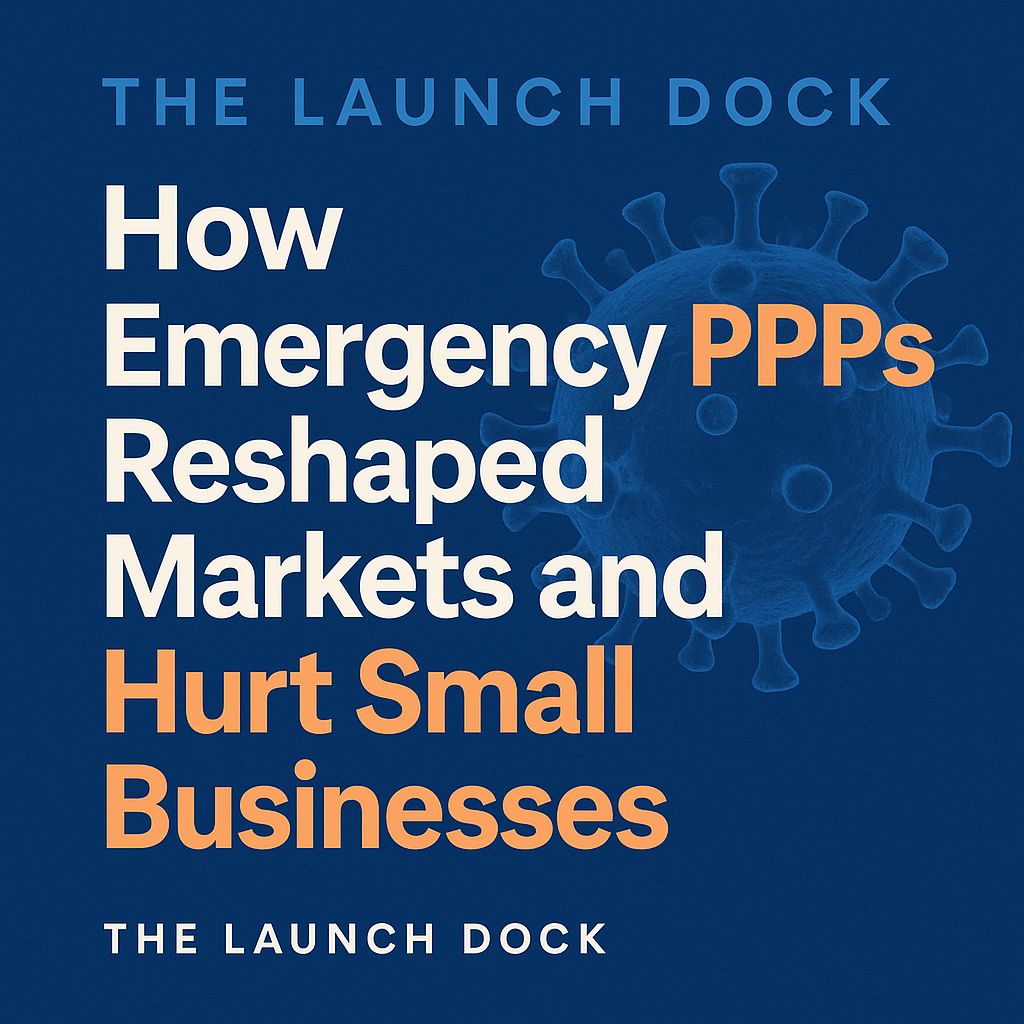- The Launch Dock
- Posts
- THE LAUNCH DOCK
THE LAUNCH DOCK
The Pandemic Power Shift: How COVID-19 PPPs Reshaped Markets and Left Small Businesses Behind

Merchant Ship Collective | The Launch Dock
“Where small businesses learn the truth about power, policy, and opportunities that actually matter.”
The Pandemic Power Shift
When COVID-19 hit, the world entered crisis mode overnight. Here in the United States, no sector was prepared — not healthcare, not education, not public infrastructure, not supply chains. In that vacuum, Public–Private Partnerships (PPPs) became the fastest and most politically convenient solution to keep the country functioning.
Many of those partnerships were necessary. Some saved lives. Some stabilized critical systems.
But beneath the surface, something else was happening:
COVID-19 didn’t just expand PPPs. It rewired entire markets in ways that continue to disadvantage small businesses today.
This issue examines that shift — not with blame, but with clarity.
How COVID-19 Turned PPPs Into the Default Answer
In the chaos of early 2020, government agencies were under enormous pressure.
Testing backlogs were growing, hospitals lacked capacity, schools needed remote infrastructure, and supply chains failed all at once. Under emergency protocols, agencies were allowed to skip competitive bidding, accelerate procurement, and sign contracts directly with private vendors.
This unprecedented level of emergency contracting created a new power structure: national corporations suddenly became the backbone of public systems. The Government Accountability Office later confirmed that COVID-19 emergency procurement “substantially reduced competition” and weakened transparency requirements (Government Accountability Office, 2021).
For small businesses, this was the beginning of a long-term structural disadvantage.
The Quiet Shift That Changed Everything
COVID-era PPPs didn’t just provide temporary services; they replaced local ones.
Across the country, long-standing small businesses in food service, IT support, cleaning, transportation, healthcare, diagnostics, and education technology were pushed aside in favor of large corporations with the scale, staffing, and logistics to operate in a crisis.
Many small businesses weren’t just competing — they were never even considered.
By the time states returned to normal operations, the “temporary” arrangements had become the new standard. Systems built under emergency authorization remained in place. Vendors integrated deeply into public infrastructure. Contracts quietly renewed. Local providers were no longer part of the equation.
And most communities didn’t realize what had happened until the opportunity was already gone.
Healthcare and Testing: How Big Labs Took Over
Before COVID-19, many states relied on a blend of small diagnostic labs, hospital-based labs, and regional providers. The pandemic changed that almost instantly. National chains like Quest and LabCorp secured contracts for mass testing that sidelined smaller labs that previously served their communities.
Once these big contracts were signed, the infrastructure followed: data pipelines, reporting platforms, and reimbursement systems all began running through national vendors. Even after the emergency ended, these systems remained in place — giving large companies permanent dominance in statewide diagnostics.
Small labs didn’t just lose business. Some lost entire revenue streams.
Education Technology: The Rise of Big Tech as Public Infrastructure
Before 2020, most school districts used a patchwork of local technology providers, small EdTech partners, and district-developed systems. But remote learning required rapid, large-scale solutions — and only Big Tech could deliver them overnight.
Google Classroom, Microsoft Teams, and Zoom became the new educational backbone. Private learning platforms, digital attendance tools, and surveillance-based engagement systems followed. Many districts signed multi-year contracts under emergency authority.
Once adopted, these platforms reshaped:
Attendance tracking
Student data collection
Communication
Grading
Curriculum access
Local IT vendors, tutors, and EdTech startups never stood a chance.
These systems are still in place today.
Supply Chain and Logistics: The End of Local Contracting
The federal government relied heavily on national distributors to move:
PPE
Food for emergency school programs
Medical supplies
Vaccines
Testing materials
These vendors had the trucks, warehousing, and nationwide reach to deliver quickly in a crisis. But small businesses who previously held local contracts were pushed out without recourse.
Many never regained their contracts after the crisis — not because of poor performance, but because the system had permanently changed around them.
Data Control: The Most Important Shift You Didn’t See
One of the least discussed — and most consequential — outcomes of COVID-19 PPPs was the centralization of public data inside private platforms.
During the pandemic, private vendors collected:
Health data
Testing records
Business relief applications
School attendance and engagement metrics
Contact tracing information
Hospital capacity data
These systems were not designed as short-term solutions. Many became the foundation for broader state and federal public health dashboards, grant systems, or educational data platforms.
Because these systems are privately owned, they often fall outside public FOIA requirements (United States Department of Health & Human Services, 2022). This means small businesses — and the public — have limited ability to access or audit the data that governs future contracts, compliance, and public decisions.
The power imbalance isn’t theoretical. It’s structural.
The Long-Term Impact on Small Businesses
As we move deeper into the post-pandemic era, the consequences of these COVID-era decisions are clear:
Local vendors were replaced by national partners, and many of those partnerships became permanent.
Digital systems adopted during the emergency now shape who sees opportunities and who doesn’t.
Contracting pipelines remain consolidated.
Small businesses face higher compliance barriers and more complex digital requirements.
Public data, once accessible, is now locked inside proprietary systems that small firms cannot influence.
COVID-19 didn’t just change health policy or education. It changed the architecture of how public systems operate — in ways that deeply disadvantage local businesses.
What Small Businesses Can Do Now
While the damage is real, the path forward is not hopeless. The first step is understanding how your city, county, and state changed during COVID. The second step is ensuring those emergency systems don’t become untouchable.
Small businesses can:
Track contract renewals and ask when emergency agreements expire
Advocate for open bidding instead of automatic extensions
Push for local-vendor set-asides
Request transparency for digital procurement systems
Collaborate with other local businesses to monitor PPP developments
Change starts with awareness — and collective advocacy.
Call to Action
In the next issue of The Launch Dock, we examine the legal loopholes that allow PPPs to bypass public oversight — and how those loopholes disproportionately impact small businesses.
These are the rules of the game.
And it’s time small businesses knew exactly how the game is played.
In solidarity,
Lyndsay LaBrier
The Merchant Ship Collective
References
Government Accountability Office. (2021). COVID-19: Emergency contracting and the need for transparency. https://www.gao.gov
United States Department of Health & Human Services. (2022). Public health data infrastructure modernization update. https://www.hhs.gov
United States Department of Agriculture. (2025, February 26). USDA invests $1 billion to combat avian flu and reduce egg prices [Press release]. https://www.usda.gov
Shoppers are adding to cart for the holidays
Peak streaming time continues after Black Friday on Roku, with the weekend after Thanksgiving and the weeks leading up to Christmas seeing record hours of viewing. Roku Ads Manager makes it simple to launch last-minute campaigns targeting viewers who are ready to shop during the holidays. Use first-party audience insights, segment by demographics, and advertise next to the premium ad-supported content your customers are streaming this holiday season.
Read the guide to get your CTV campaign live in time for the holiday rush.

